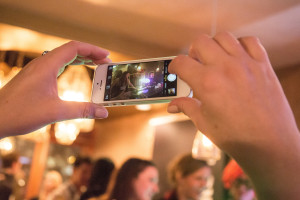Use UX (User Experience) Methodology to Streamline Your Business Meetings
At the 2015 SXSW Panel “The Productive Workplace: UX, Technology and You”, I spoke about how companies can apply a UX (user experience) approach and methodology to the workplace. Since then I have found that you can apply yet more of the principals in UX thinking to various facets of business – specifically, meetings.
At its core, UX is a methodology that focuses on users. It uses a deep understanding of people to piece together cohesively all the elements of an interactive experience to accomplish a desired goal. This same framework and thought process can also be applied to meeting in the business world.
Meetings — or “meeting mayhem” as it may be better referred to! — are often the bane of many a professional’s life. We have countless meetings these days: back-to-back throughout the day, meetings-to-plan meetings…and the list continues. In fact, 93% of people we surveyed thought that one quarter to one half of their meetings were unnecessary!
To tackle this, I have found that mastering parts of the UX thought process can help you do two things: 1) Minimize the time you are in unnecessary meetings and 2) Enable you to better achieve the goal of your meeting. Both these outcomes will help you to work more effectively, as well as freeing up more of those precious minutes in your day.
MINIMIZING THE POINTLESS MEETINGS
There are two ways in which you can reduce your meetings to just those of importance:
Understand the Meeting’s Role and Goal
In UX design, we often start with a vision or a mission to describe the goal of the experience, and keep us focused on what we need to achieve.
In a similar way, each meeting you have is likely playing a role in a larger project or deliverable. Ask yourself what the actual mission of the whole project or deliverable is. Then think about what part this particular meeting plays in that larger aim. You may find that the aim/end goal can be achieved without the need for a meeting.
Understand Your Role
Are you listening in? Is the topic useful to you? Are you speaking to a topic? Note: you should also be able to definitively answer the question “Should I even be there?” The reason for this: it is a common fact that all the people present in a meeting do not always have a reason to be there, meaning the meeting is not a valuable use of their time. You might recognize two particular aimless attendees in the following categories:
“The Nosey Parker” – Yes, we all like to be apprised of what is going on; however, if you really have no stake in the meeting, catch the update later. Your time is precious.
“The Courtesy Invite” – i.e. “I should invite them so no one feels left out.” This is not a high school party. If you feel like you are “invited just because,” then it is okay not to attend.
I was once in a meeting where our VP started with “Thank you all for being here. We will take a brief moment to introduce ourselves and state our role in this meeting as it pertains to goal.” To anyone that did not actually have a real stake, he politely followed the intros with “Thank you, we will absolutely call you in if we need you. As for now, I don’t think this will be a valuable use of your time.” The meeting was probably much more effective due to this start.
INCREASING MEETING EFFECTIVENESS
There are three UX principals you can apply to increase the effectiveness of your meetings.
1. Know What Success Is
In UX, we define what a successful experience will be for a user, so that we can drive the achievement of the goal towards that.
You can ask the same of a meeting – what are we trying to achieve? A couple of common aims might be:
-
-
- Achieve Awareness – To bring awareness to help the overall project or deliverable.
- Obtain “Buy-In” – To get stakeholders to buy in on a decision.
- Convince – To convince people of your side of a “debate.”
- Listen – You are directly impacted by the decisions or outcomes in the meeting.
-
Of course there are many more, and knowing what you want to get out of it (specifically) will help you prepare for the meeting more effectively.
2. Know the People
“Know your Users” is the absolute core of Experience Design and, again, we can use some of these principals in our “meeting arsenal” to help us achieve our purpose.
So ask the following: who are the people involved? And more importantly, who are the “power people?” These are either the people whom others respect and listen to; the people who make the final decision; or the people whom the decision-makers listen to. Who will be the people you should focus on to achieve your goal?
Just as observation is the key to unlocking insights in UX, you can also use this thought process to help you truly understand the people you are working with. For instance, if you are speaking, you should start to notice what people respond well to, and not so well to — and then how best to get their attention.
For example, is someone bringing a little too much ego? You should also start noticing the little things that show you a person’s “hand” — their “hot buttons,” so to speak. Sometimes it’s the look they give or an action they make. Sometimes it might be a phrase they use (very useful in virtual meeting situations). Some are more subtle than others, but we all have them. You will begin to create “personas,” much like we do in UX, as you come to realize that there are “attendee types” you will meet over and over again.
This will all help you to approach people in the best way possible to achieve your goal.
3. Design and Deliver
Just as in UX we use the insights of our users to design and deliver an experience, you too can use some of this thought process for your meeting.
For instance, we have a User Interface (UI) in UX that the user can view and interact with, just like a meeting has audio and visual materials to be created and delivered. With your knowledge of the users, you can determine the best way to deliver the content to them for maximum effectiveness.
This sometimes comes down to: what style should you use? I have one colleague who responds best to a workshop style, where they are an active part of a session. That said, I also know several people for whom the content must be delivered in a fashion that allows them to “come up with the idea” as their own.
All of the above is a way of noting a potentially useful remedy for the fact that while meetings are an important tool, the sheer number that takes place in a business setting has led to a state where you might often find yourself in a meeting for “the sake of a meeting.”
Instead, using some of the UX thought process will not only help you to plan better, more effective gatherings, it will also help you determine whether holding or attending a face-to-face is really the best way to solve that particular problem. This in turn should aid you in conducting better business, achieving more success for the company and, perhaps most importantly, giving you back your precious time!
Written by: Sarah Deane (@4HourUX) Clique Intelligence
SXSW Presentation – The Productive Workplace: UX, Technology and You
13TAGS: SXSW
 Interviewer Interview Prep
Interviewer Interview Prep Impactful Mentees
Impactful Mentees Benefits of a Mentor
Benefits of a Mentor Advice for First-Time Managers
Advice for First-Time Managers Overcoming the 18-month Itch
Overcoming the 18-month Itch Dressing for Your Style
Dressing for Your Style Interview Style Tips
Interview Style Tips Women's Stocking Stuffers
Women's Stocking Stuffers Gift the Busy Traveler
Gift the Busy Traveler Father’s Day Gift Guide
Father’s Day Gift Guide Airport Layover Activities
Airport Layover Activities Traveling & Eating Healthy
Traveling & Eating Healthy Travel Like a Boss Lady
Travel Like a Boss Lady The Dual California Life
The Dual California Life Gifts for Thanksgiving
Gifts for Thanksgiving Summer Reading List
Summer Reading List Top Leisurely Reads
Top Leisurely Reads New Year, New Books
New Year, New Books Life Lessons from a Sitcom
Life Lessons from a Sitcom Oprah, Amy or Amal?
Oprah, Amy or Amal?














